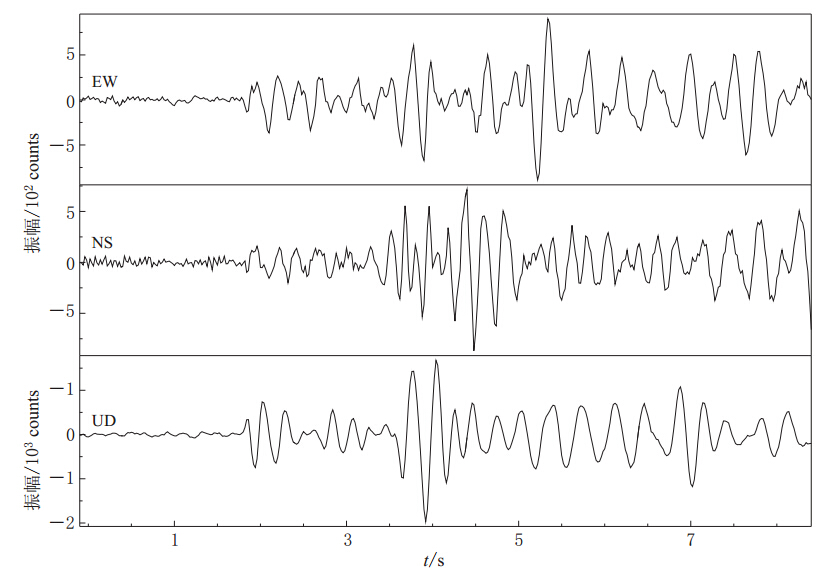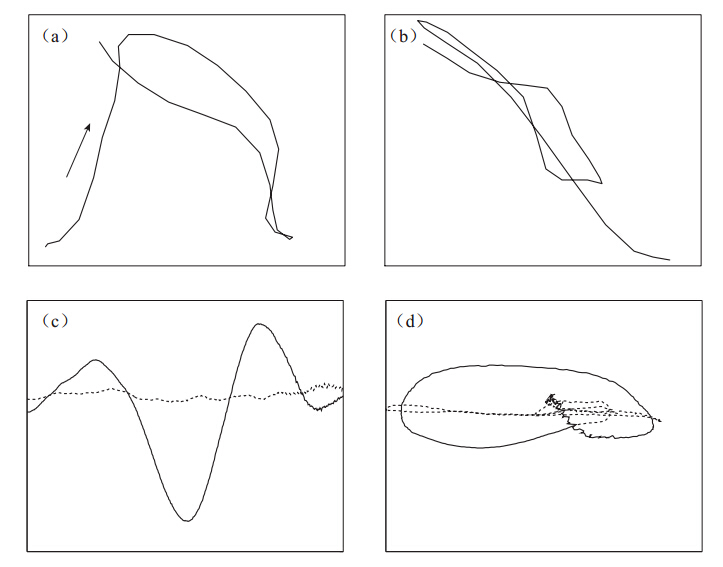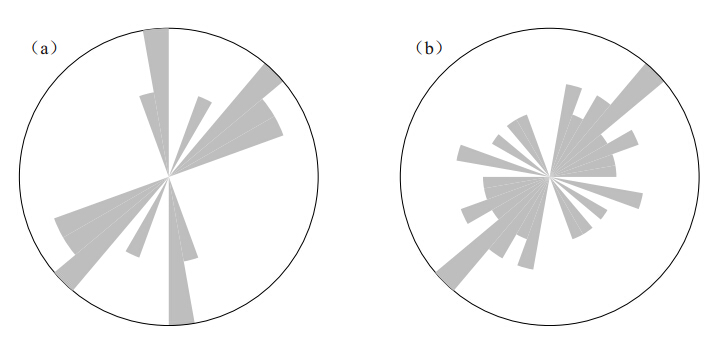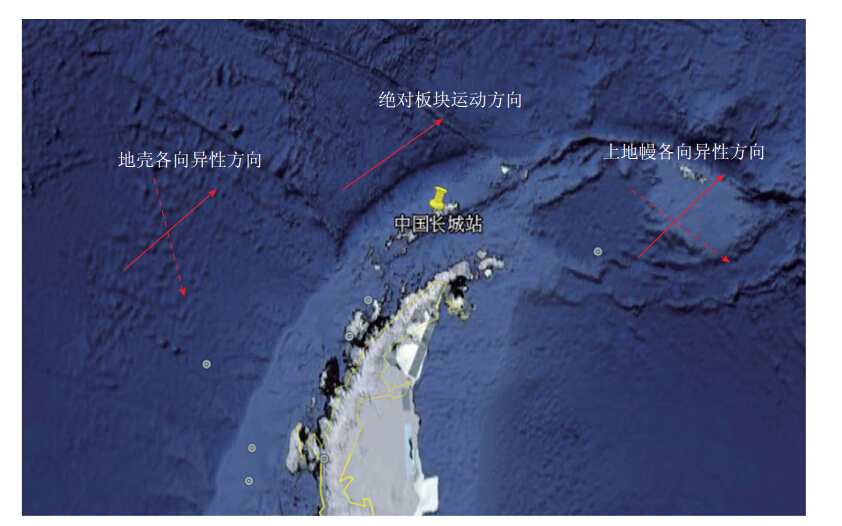Anisotropy in the crust and upper mantle at the Great Wall seismic station in Antarctica
-
摘要: 利用我国第24次和第25次南极科学考察队于2008年2月—2010年3月南极长城站记录到的地震事件数据进行剪切波分裂研究. 选取近震事件对Sg波进行剪切波分裂计算,结果表明快波偏振方向有两个,分别为北东向和近南北向; 慢波延迟时间的范围为1.45—5.17 ms/km,平均值为3.54 ms/km.同时选取长城站记录到的远震数据SKS波震相进行剪切波分裂计算,得出上地幔快波偏振方向优势取向为北东向, 慢波延迟时间平均值为1.60 s. 剪切波分裂结果显示长城站地区地壳和上地幔具有明显的各向异性, 并显示长城站地区地壳与上地幔快波偏振方向几乎平行,表明壳幔变形的一致关系.另外,地壳和上地幔各向异性的快波偏振方向不仅与长城站附近的海沟方向平行,同时也与绝对板块的运动方向平行.该结果进一步说明了绝对板块的运动是构成上地幔各向异性的主要原因.Abstract: Using the earthquake events from February 2008 to March 2010 recorded by the Great Wall seismic station in Antarctica, which is from the 24th and 25th Antarctic scientific expeditions, this paper studies the shear wave splitting. By choosing the local earthquakes and using Sg waveforms to study the shear wave splitting, the polarization direction of the fast wave are northeast and nearly north-south. The delay time of the slow wave is in the range of 1.45—5.17 ms/km with the average value being 3.54 ms/km. By choosing the teleseismic events and using SKS waveforms to calculate the parameters of shear wave splitting, the polarization direction of the fast wave is northeast, and the average delay time of the slow wave is 1.60 s. The results of shear wave splitting shows that the anisotropy in the crust and upper mantle is obvious. And the polarization direction of fast wave in the crust is parallel to that in the upper mantle, which indicates the deformation in the crust and upper mantle is identical. In addition, the anisotropic directions of fast wave polarizations in the crust and mantle are parallel to the direction of ocean trench around the Great Wall seismic station and to the direction of the absolute plate motions, which further suggests that the absolute plate motions are the primary cause of the upper mantle anisotropy.
-
Keywords:
- crust /
- mantle /
- shear wave splitting /
- anisotropy
-
-
图 3 剪切波分裂示意图(a),(b)分别为2008年5月11日22时12分6秒地震Sg波的质点偏振图和偏振校正后的线性质点偏振图;(c),(d)分别为2009年8月10 日4时6分31秒地震SKS波径向(实线)和切向(虚线)分量,及其校正前(实线)、后(虚线)的质点偏振图
Figure 3. The diagrams of shear-wave splitting (a) and (b)are the trail of particle of Sg wave from the earthquake at 22:12:06 on May 11 2008,before and after the polarization correction,respectively.(c)is the radial(solid line) and transverse(dashed line)components of the SKS wave from the earthquake at 04:06:31 on 10 August 2009,and (d)is the trail of particle of SKS wave before(solid line) and after(dashed line)the polarization correction,respectively
图 5 各向异性与构造之间的关系. 实线箭头表示地壳和上地幔北东向的快波偏振方向,虚线箭头表示地壳和上地幔南东向的快波偏振方向
Figure 5. Relationship between the anisotropic direction and tectonic structure Solid arrows are the NE fast wave polarization direction from the crust and upper mantle; dashed arrows are the SE fast wave polarization direction from the crust and upper mantle
表 1 地壳剪切波分裂参数
Table 1 The parameters of shear wave splitting in the crust

表 2 上地幔剪切波分裂参数
Table 2 The parameters of shear wave splitting in the upper mantle

-
常利军, 王椿镛, 丁志峰, 周民都, 杨建思, 徐智强, 姜旭东, 郑秀芬. 2008. 青藏高原东北缘上地幔各向异性研究[J]. 地球物理学报, 51 (2): 432-438. Chang L J, Wang C Y, Ding Z F, Zhou M D, Yang J S, Xu Z Q, Jiang X D, Zheng X F. 2008. Seismic anisotropy of upper mantle in the northeastern margin of the Tibetan Plateau[J]. Chinese Journal of Geophysics, 51 (2): 432-438 (in Chinese).
高原, 郑斯华, 王培德. 1996. 海南省东方地区1992年小震群剪切波分裂研究[J]. 地球物理学报, 39 (2): 221-232. Gao Y, Zheng S H, Wang P D. 1996. Shear wave splitting study on small earthquake swarm of 1992 in Dongfang of Hainan, South China[J]. Acta Geophysica Sinica, 39 (2): 221-232 (in Chinese).
贾国强. 1990. 1986年冬季中国南极长城站的地震观测[J]. 极地研究, 2 (2): 81-85. Jia G Q. 1990. Seismological observation at the Great Wall station during austral winter of 1986[J]. Advances in Polar Science, 2 (2): 81-85 (in Chinese).
罗艳, 黄忠贤, 彭艳菊, 郑月军. 2004. 中国大陆及邻区SKS波分裂研究[J]. 地球物理学报, 47 (5): 812-821. Luo Y, Huang Z X, Peng Y J, Zheng Y J. 2004. A study on SKS wave splitting beneath the China mainland and adjacent regions[J]. Chinese Journal of Geophysics, 47 (5): 812-821 (in Chinese).
石玉涛, 高原, 赵翠萍, 姚志祥, 太龄雪, 张永久. 2009. 汶川地震余震序列的地震各向异性[J]. 地球物理学报, 52 (2): 398-407. Shi Y T, Gao Y, Zhao C P, Yao Z X, Tai L X, Zhang Y J. 2009. A study of seismic anisotropy of Wenchuan earthquake sequence[J]. Chinese Journal of Geophysics, 52 (2): 398-407 (in Chinese).
田宝峰, 杨建思, 刘莎, 郑钰, 姜旭东, 徐志强. 2012. 南极地震学研究进展[J]. 地震学报, 34 (2): 267-279. Tian B F, Yang J S, Liu S, Zheng Y, Jiang X D, Xu Z Q. 2012. Progress of seismological research in Antarctica region[J]. Acta Seismologica Sinica, 34 (2): 267-279 (in Chinese).
Anandakrishnan S, Winberry J P. 2004. Antarctic subglacial sedimentary layer thickness from receiver function analysis[J]. Global Planet Change, 42 (1/2/3/4): 167-176.
Bannister S, Yu J, Leitner B, Kennett B L N. 2003. Variations in crustal structure across the transition from west to east Antarctica, Southern Victoria Land[J]. Geophys J Int, 155 (3): 870-880.
Crampin S. 1985. Evaluation of anisotropy by shear-wave splitting[J]. Geophysics, 50 (1): 142-152.
Crampin S. 1999. Stress forecasting earthquakes[J]. Seism Res Lett, 70 (3): 291-293.
Gripp A E, Gordon R G. 1990. Current plate velocities relative to the hotspots incorporating the NUVEL-1 global plate motion model[J]. Geophys Res Lett, 17 (8): 1109-1112.
Hayes D E. 1991. Tectonics and age of the oceanic crust: Circum-Antarctic to 30°S [C]//Hayes D E ed. Marine Geological and Geophysical Atlas of the Circum-Antarctic to 30°S. Washington: American Geophysical Union: 47-56.
Hess H H. 1964. Seismic anisotropy of the uppermost mantle under oceans[J].Nature, 203 (4945): 629-631.
Kaminuma K, Ishida M. 1971. Earthquake activity in Antarctica[J]. Nankyoku Shiryo: Antarct Rec, 42 : 53-60.
Kaminuma K. 1995. Seismicity around the Antarctic Peninsula[J]. Proc NIPR Symp Antarct Geosci, 8 : 35-42.
Mainprice D, Silver P G. 1993. Interpretation of SKS-wave using samples from the subcontinental lithosphere[J]. Phys Earth Planet Inter, 78 (3/4): 257-280.
Müller C. 2001. Upper mantle seismic anisotropy beneath Antarctica and the Scotia Sea region[J]. Geophys J Int, 147 (1): 105-122.
Nicolas A, Christensen N L. 1987. Formation of anisotropy in upper mantle peridotites: A review[C]//Fuchs K, Froidevaux C eds. Composition Structure and Dynamics of the Lithosphere-Asthenosphere System. New York: John Wiley & Sons, Inc. , 16 : 111-123.
Pondrelli S, Azzara R. 1998. Upper mantle anisotropy in Victoria Land (Antarctica)[J]. Pure Appl Geophys, 151 (2/3/4): 433-442.
Pondrelli S, Margheriti L, Danesi S. 2005. Seismic anisotropy beneath Northern Victoria Land from SKS splitting Analysis[C]//Futterer D K, Damaske D, Kleinschmidt G, Miller H, Tessensohn F eds. Antarctica: Contributions to Global Earth Sciences. Heidelberg: Springer-Verlag: 153-160.
Reading A M. 2007. The seismicity of the Antarctic Plate[J]. Geol Soc Amer Special Papers, 425 : 285-298.
Sieminski A, Debayle E, Leveque J. 2003. Seismic evidence for deep low-velocity anomalies in the transition zone beneath west Antarctica[J]. Earth Plan Sci Lett, 216 (4): 645-661.
Silver P G, Chan W W. 1991. Shear wave splitting and subcontinental mantle deformation[J]. J Geophys Res, 96 (B10): 16429-16454.
Silver P G. 1996. Seismic anisotropy beneath the continents: Probing the depths of geology[J]. Ann Rev Earth Plant Sci, 24 (1): 385-432.
Vinnik L P, Kind R, Makayeva L I, Kosarev G L. 1989. Azimuthal anisotropy in the lithosphere from observations of long period S wave[J]. Geophys J Int, 99 (3): 549-559.
Watson T, Nyblade A, Wiens D A, Anandakrishnan S, Benoit M, Shore P J, Voigt D, VanDecar J. 2006. P and S velocity structure of the upper mantle beneath the Transantarctic Mountains, East Antarctic craton, and Ross Sea from travel time tomography[J]. Geochem Geophys Geosyst, 7 (7): Q07005. doi:10.1029/2005GC001238.
Winberry J P, Anandakrishnan S. 2004. Crustal structure of the West Antarctic rift system and Marie Byrd Land hotspot[J]. Geology, 32 (11): 977-980. doi:10.1130/G20768.1.




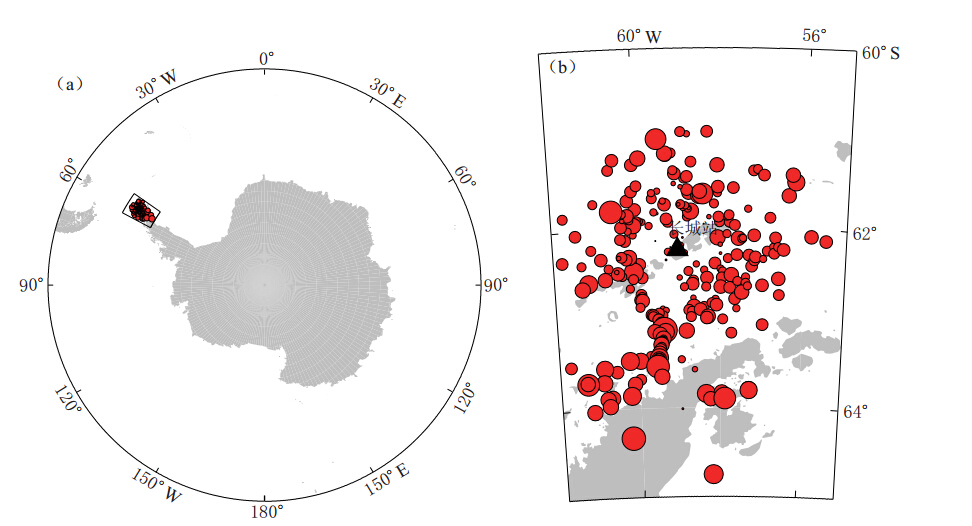
 下载:
下载:
